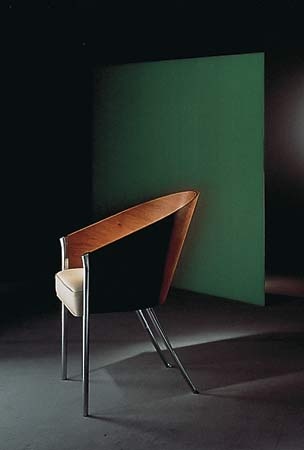Starck, Philippe
French designer
born January 18, 1949, Paris, France
French designer known for his wide range of designs, including everything from interior design to household objects to boats to watches. He has also worked as an architect.
Most likely influenced by his father, who worked as an aircraft engineer, Starck studied at the École Nissim de Camondo, Paris, and in 1968 set up his first company, which produced inflatable objects. Always interested in design as a total concept, in the 1970s he made a reputation for himself by creating interiors for clients such as the Paris nightclubs La Main Bleue (1976) and Les Bains-Douches (1978).
 Starck first gained international attention when he was commissioned to refurbish the private apartments in the Élysée Palace (1983–84) in Paris for French President François Mitterrand (Mitterrand, François). He went on to design restaurant interiors for the Café Costes (1984) in Paris, Manin (1985) in Tokyo, Theatron (1985) in Mexico City, and Teatriz (1990) in Madrid, among others. Starck was also responsible for the interior design of the Royalton and Paramount hotels (1988 and 1990) in New York City, work that subsequently inspired hotels throughout the world to seek his services. Over the course of these varied commissions, he did not develop one distinct aesthetic or a preference for certain materials. Rather, he addressed the needs of an individual client, whether it was the somewhat conservative character of state apartments or the more flamboyant tone needed for a trendy nightclub. Some constants did develop in Starck's work, however, such as a preference for fluid, organic forms and the inclusion of subtle, playful details. For example, in the Delano Hotel (1995) in the South Beach area of Miami, Florida, each room has a metal apple holder affixed to the wall; the phrase “An apple a day keeps the doctor away” is printed on the holders, promising a daily replenishment of apples.
Starck first gained international attention when he was commissioned to refurbish the private apartments in the Élysée Palace (1983–84) in Paris for French President François Mitterrand (Mitterrand, François). He went on to design restaurant interiors for the Café Costes (1984) in Paris, Manin (1985) in Tokyo, Theatron (1985) in Mexico City, and Teatriz (1990) in Madrid, among others. Starck was also responsible for the interior design of the Royalton and Paramount hotels (1988 and 1990) in New York City, work that subsequently inspired hotels throughout the world to seek his services. Over the course of these varied commissions, he did not develop one distinct aesthetic or a preference for certain materials. Rather, he addressed the needs of an individual client, whether it was the somewhat conservative character of state apartments or the more flamboyant tone needed for a trendy nightclub. Some constants did develop in Starck's work, however, such as a preference for fluid, organic forms and the inclusion of subtle, playful details. For example, in the Delano Hotel (1995) in the South Beach area of Miami, Florida, each room has a metal apple holder affixed to the wall; the phrase “An apple a day keeps the doctor away” is printed on the holders, promising a daily replenishment of apples.Parallel to his career as an interior designer, Starck developed an international reputation on the basis of his wide range of industrial designs. Often displaying the same organic, fluid lines of his interiors, the varied products he designed on commission included boats for Bénéteau, mineral-water bottles for Glacier, kitchen appliances—notably the Juicy Salif juicer—for Alessi, toothbrushes for Fluocaril, luggage for Samsonite, “Urban Fittings” for Decaux, office furniture for Vitra, televisions for Thomson Multimedia, watches for Fossil, eyeglasses for Alain Mikli, and the Optical Mouse for Microsoft. Starck's populist vision for design was best achieved in such products, which were often sold at affordable price points and through mass-market venues. Rejecting design simply for the sake of beauty or as a symbol of wealth, Starck hoped that his work would improve people's lives by adding an element of humour and surprise to everyday acts such as brushing one's teeth or cooking. The designer himself was often featured in ads for his products, since his flamboyant, lighthearted personality embodied the message of his work.
Starck also worked as an architect, with many commissions in Japan. Although not as well known as his interiors and product design, his buildings also displayed the fluid lines and playful details for which his industrial designs were known. His best-known works are the Asahi Beer Hall (1990) in Tokyo, an austere, blocklike granite building topped with a bulbous orange shape resembling a flame, and the Unhex Nani-Nani office building (1989), also in Tokyo, which has been described as a biomorphic shed. In 1997 he received the Excellence in Design Award from the Harvard Graduate School of Design.
Additional Reading
Franco Bertoni, The Architecture of Philippe Starck (1994); Christine Colin, Starck (1988); Conway Lloyd Morgan, Starck (1999).
- Machado, Manuel
- Machado y Morales, Gerardo
- Machala
- Machatý, Gustav
- Machaut, Guillaume de
- Machel, Samora
- Machen, Arthur
- Machen, John Gresham
- Mach, Ernst
- Machias
- Machiavelli, Niccolò
- Machida
- machine
- machine gun
- Machine Gun Kelly
- machine language
- machine tool
- machine-tractor station
- Machin, John
- Mach number
- Machray, Robert
- Mach's principle
- Machu Picchu
- Macina
- MacInnes, Helen Clark